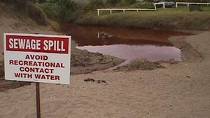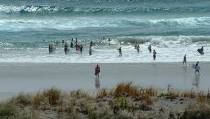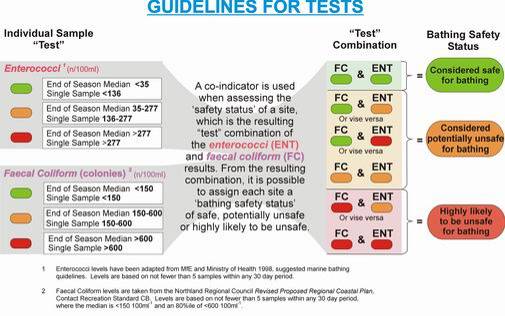Recreational Bathing Water Quality
Within this section…
The Northland Regional Council implements the recreational bathing programme every summer during the peak bathing season to assess nearshore coastal water quality, in terms of microbial risk to human health. Contamination of nearshore coastal waters may result from various sources including sewage leaks, septic tank seepage, sewage discharges from boats, contaminated stormwater and diffuse run-off from the land. The Regional Council's responsibility is to carry out routine surveillance monitoring. These results are forwarded to the District Councils and Northland Health, who then carry out follow up sampling as required and warn the public of any bathing sites that may be unsuitable for recreational use.

 A sign warns of sewage spill (above) while people enjoy the surf (below).
A sign warns of sewage spill (above) while people enjoy the surf (below).
The bathing programme including site selection, methods, follow up and guideline values, is based on the ‘Microbiological Water Quality Guidelines for Marine and Freshwater Recreational Areas' developed by the Ministry for the Environment and Ministry of Health. These guidelines are available under publications on the Ministry for the Environment's website: www.mfe.govt.nz. In general, samples were collected on a weekly basis from each site and analysed for concentrations of two indicator bacteria, enterococci and faecal coliform. These are indicative of pathogen levels and therefore the potential risk of illness to recreational users.
Guidelines for Marine Bathing Water Quality in Northland
The guidelines below show how the results of the water quality tests are combined to determine the ‘bathing safety status' at each site. An elevated concentration of both enterococci and faecal coliform occurring at one site is considered more indicative of a significant water quality issue than only one being elevated.

Summary of 2005-06 results
In 2005-2006 Northland Regional Council carried out surveillance monitoring at 58 marine bathing sites throughout Northland for 12 weeks from late November 2005 to mid February 2006. The microbiological results from the 2005-06 bathing season are summarised below. Refer to Appendix one for the maps showing the results of the 12 weeks of sampling.
Matapouri
The water quality complied with the bacteriological guidelines for recreational bathing on all occasions for the beach sampling site. However, non-compliances were detected in the estuary on four occasions.
Tutukaka
The water quality at Church Bay proved problematic, with a period of non-compliance for five weeks in a row. This was investigated by Council and results indicated contamination occurring from the rural catchment. Pacific Bay and Kowharewa Bay complied with the bacteriological guidelines on all but one occasion each.
Ngunguru
Non-compliances were detected in Ngunguru estuary on five separate occasions in the 2005-06 bathing season.
Oakura, Ohawini and Teal Bay (Ngawai Bay)
The water quality within the Oakura and Ohawini embayments complied with the bacteriological guidelines for recreational bathing on all occasions. While four non-compliances with the bacteriological guidelines for recreational bathing were recorded for Teal Bay.
Taipa/Mangonui Harbour
The water quality at Taipa and Cable Bay and Coopers Beach complied with the bacteriological guidelines for recreational bathing on most occasions. Five non-compliances were detected for Coopers Beach. The semi-brackish waters associated with these samples, as indicated by reduced salinities, indicates influence from the adjacent Coopers Beach stream.
Whangarei Heads
The water quality at McLeod Bay, Taurikura and Urquharts Bay complied with the bacteriological guidelines for recreational bathing on most occasions.
Pataua
The water quality within the lower Pataua Estuary and Pataua North beach complied with the bacteriological guidelines for recreational bathing on most occasions.
Bay of Islands
The water quality within and adjacent to Russell, Paihia, Opua and the Kerikeri and Te Puna Inlets complied with the bacteriological guidelines for recreational bathing on all occasions in 2005-06. There is some concern that samples may have been collected in deeper than 0.5 m on some sampling occasions, which may have skewed the data positively towards compliance.
Hokianga Harbour
The water quality of the Hokianga Harbour at Omapere, Opononi and Horeke complied with the bacteriological guidelines for recreational bathing on most occasions. Rawene was non-compliant with the guidelines for half of the sampling events.
Kaipara Harbour
The water quality within the Kaipara Harbour, at Pahi and Kellys Bay complied with the bacteriological guidelines for recreational bathing on most occasions. Tinopai was quite different, with numerous non-compliances. Many of these non-compliances were correlated with semi-brackish waters present during sampling.
Ruakaka, Waipu, and Langs
The water quality at Ruakaka Estuary failed to comply with the guideline on seven occasions. However, the brackish waters associated with the samples (7 samples with salinity < 20 ppt) question the validity of this site in the marine recreational bathing programme.
The Ruakaka beach site had three non-compliances, possibly resulting from influence of plume from Ruakaka River. While Waipu and Langs Beach were compliant on most occasions.
Mangawhai
The overall water quality within the lower Mangawhai Estuary complied with the bacteriological guidelines for recreational bathing on most occasions. There was only one occasion when the FC and ENT levels exceeded the guideline.
Overall summary
In general, water quality in most of Northland's nearshore coastal waters comply with microbial water quality guidelines for recreational use. However, following heavy rainfall water quality tends to decline in some areas and can remain compromised for several days. At open coast locations water quality tends to be less affected by rainfall than that at estuarine or harbour locations, where contaminants may become concentrated under conditions of limited tidal flushing.
All sites monitored during the 2005-06 summer will remain for next year's marine bathing programme. A review of all marine sites, which will involve grading sites following the protocols set out in the ‘Microbial Water Quality guidelines For Marine and Freshwater Recreational Areas' will be done in the next 2 years.
